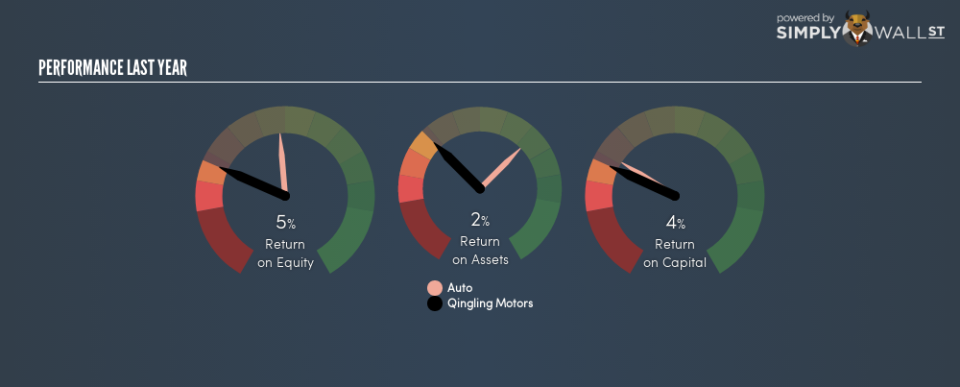Why We’re Not Impressed By Qingling Motors Co., Ltd.’s (HKG:1122) 4.1% ROCE

Today we’ll evaluate Qingling Motors Co., Ltd. (HKG:1122) to determine whether it could have potential as an investment idea. In particular, we’ll consider its Return On Capital Employed (ROCE), as that can give us insight into how profitably the company is able to employ capital in its business.
First of all, we’ll work out how to calculate ROCE. Then we’ll compare its ROCE to similar companies. And finally, we’ll look at how its current liabilities are impacting its ROCE.
What is Return On Capital Employed (ROCE)?
ROCE is a metric for evaluating how much pre-tax income (in percentage terms) a company earns on the capital invested in its business. All else being equal, a better business will have a higher ROCE. Ultimately, it is a useful but imperfect metric. Renowned investment researcher Michael Mauboussin has suggested that a high ROCE can indicate that ‘one dollar invested in the company generates value of more than one dollar’.
How Do You Calculate Return On Capital Employed?
Analysts use this formula to calculate return on capital employed:
Return on Capital Employed = Earnings Before Interest and Tax (EBIT) ÷ (Total Assets – Current Liabilities)
Or for Qingling Motors:
0.041 = CN¥338m ÷ (CN¥11b – CN¥2.6b) (Based on the trailing twelve months to June 2018.)
So, Qingling Motors has an ROCE of 4.1%.
See our latest analysis for Qingling Motors
Want to help shape the future of investing tools and platforms? Take the survey and be part of one of the most advanced studies of stock market investors to date.
Is Qingling Motors’s ROCE Good?
One way to assess ROCE is to compare similar companies. We can see Qingling Motors’s ROCE is around the 4.8% average reported by the Auto industry. Independently of how Qingling Motors compares to its industry, its ROCE in absolute terms is low; especially compared to the ~2.0% available in government bonds. It is likely that there are more attractive prospects out there.
Remember that this metric is backwards looking – it shows what has happened in the past, and does not accurately predict the future. Companies in cyclical industries can be difficult to understand using ROCE, as returns typically look high during boom times, and low during busts. This is because ROCE only looks at one year, instead of considering returns across a whole cycle. How cyclical is Qingling Motors? You can see for yourself by looking at this free graph of past earnings, revenue and cash flow.
How Qingling Motors’s Current Liabilities Impact Its ROCE
Liabilities, such as supplier bills and bank overdrafts, are referred to as current liabilities if they need to be paid within 12 months. The ROCE equation subtracts current liabilities from capital employed, so a company with a lot of current liabilities appears to have less capital employed, and a higher ROCE than otherwise. To counteract this, we check if a company has high current liabilities, relative to its total assets.
Qingling Motors has total assets of CN¥11b and current liabilities of CN¥2.6b. As a result, its current liabilities are equal to approximately 25% of its total assets. This is not a high level of current liabilities, which would not boost the ROCE by much.
The Bottom Line On Qingling Motors’s ROCE
That’s not a bad thing, however Qingling Motors has a weak ROCE and may not be an attractive investment. Of course you might be able to find a better stock than Qingling Motors. So you may wish to see this free collection of other companies that have grown earnings strongly.
If you like to buy stocks alongside management, then you might just love this free list of companies. (Hint: insiders have been buying them).
To help readers see past the short term volatility of the financial market, we aim to bring you a long-term focused research analysis purely driven by fundamental data. Note that our analysis does not factor in the latest price-sensitive company announcements.
The author is an independent contributor and at the time of publication had no position in the stocks mentioned. For errors that warrant correction please contact the editor at editorial-team@simplywallst.com.

